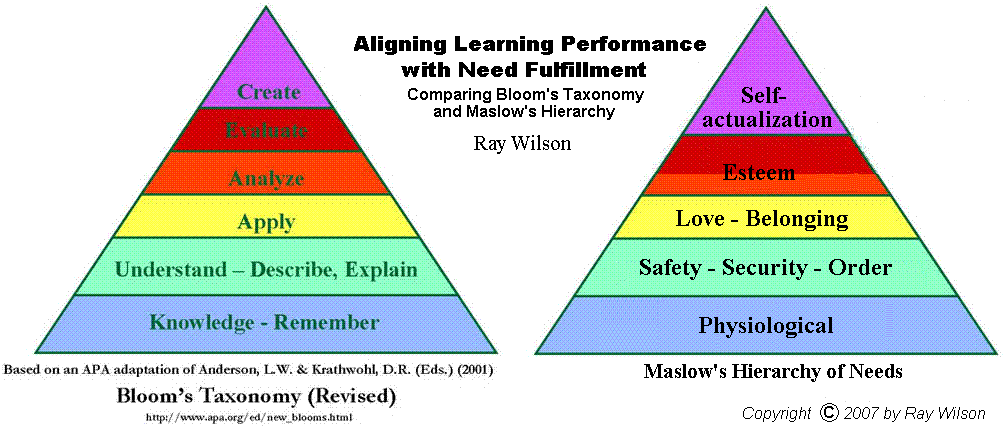The switch from nouns such as "knowledge" to verbs such as "remember" − from things to actions − is aimed at a "new" emphasis on the student. "Things" like knowledge, understanding, or content, are regarded as the teacher's objectives. "Actions" like remembering are those of the student, not the teacher, behavioral elements susceptible to observation and measurement.
The rhetorical case is made for student behavior being something other than the teacher's objective, and that a verb reflects the one and a noun the other. Not convincing, however, is any implication that teachers using the un-revised taxonomy were not already fully focused on the student learning outcomes sanctified in the revised taxonomy, or less clear on the use of behavioral measures to adjust and improve both teaching and learning performance.
There is nothing new about using tangible behaviors as measurable indicators of state-of-mind changes. When a state-of-mind change is the objective of management, counseling, or teaching effort, the only immediately observable outcome is often behavioral, and thus the default short-term performance measure. Nevertheless, that does not justify a pretense that the behavioral outcome was the target all along. Professionals should never lose sight of their objectives. The revision to Bloom's Taxonomy is often touted as a rationale for teachers to do just that, to shift "emphasis from ... instructional objectives ... to student learning outcomes...." (CUTLA, above). The notion of engaging the student as active learner is common sense, but not served by limiting focus to observable behavior and turning a blind eye to the objective of more substantial long-term intellectual development, all under the guise of "more emphasis on the student."
Intriguingly, the switch from objectives to behaviors (tasks) is treated as a management advance, while mainstream management theory has evolved in the opposite direction from task management to "management by objectives" (MBO ala Peter Drucker). Business has learned that objectives give life and reason to action − not the reverse.
Bloom's Taxonomy is a tool of the teacher, guiding what the teacher does, and should serve the teacher's objectives. That does not de-emphasize the student at all, since the student is the object of the teaching. Quite the reverse, the revision's turn away from objectives obscures the very reason for a taxonomy of education in the first place − a guide for "education by objectives" − for providing the intellectual tools for learners to purposefully apply as life circumstances require, i.e., in meeting the evolving objectives of their own lives, including their lives as students.
The revised taxonomy's artificial distinction between teachers' objectives and students' outcomes misses the fact that the objective of the one to deliver can be paralleled by the objective of the other to receive. Educational motivation is about coaxing someone to adopt objectives and to desire the knowledge and technique to meet those objectives. Bloom's Taxonomy − un-revised − provided rational schemata for understanding the rational progression of such objectives as they apply to the assessment of learning performance.
Objectives are operationalized needs, the intended results, outcomes and changes potentially achievable through specific strategic effort. The classic taxonomy categorizing human need is Maslow's Hierarchy, and the parallels to Bloom's Taxonomy are inescapable. At the base (blue), the individual is fully preoccupied with the survival needs of location and moment: the objective is survival; behavior outcome is complete assignment or achieve grade. Future or physically remote opportunities, rewards, relationships, and higher callings are beyond even the next (post survival) need horizon (green) for stability and order. To teach effectively at each ascending level of Bloom's Taxonomy requires motivating toward objectives that can be at least envisioned by each student from his/her current place in Maslow's Hierarchy. It requires not only assessing what is being learned, but also what can be learned, and what the student deems worth learning. It is essential to push back and down the horizons which obstruct the student's vision of possibilities and retard development of each student's individual learning objectives. Ironically, that means the teacher's behavioral outcomes (teaching objectives) really are to open and cultivate the long-term subjectivity of students. Objective measurement being impossible, we trust in subjective (and yet rational) understanding of each student's needs in the move from classroom to real-world imprecision.

I am convinced that the keys to doing that in secondary education are in the possession of the English, Drama, and Social Studies departments. All three provide windows to worlds beyond those of the immediate experience of the typical student, and yet of the social reality in which they all already participate. These are the academic departments and subject areas which directly serve the ultimate mission of all education and the proclaimed mission of virtually all educational institutions with formal mission statements, i.e., to integrate students into human society as socially responsible and productive participants. The English and Drama Departments make it subjectively interesting (even entertaining) and hone social and intellectual skills and senses in what might be dubbed "life simulators." The Social Studies Department is by definition the prime instructional conduit of the major educational mission of social awareness and responsibility, charged with accomplishing that through disciplined philosophical and scientific objectivity in real-time field observation and reporting.
The Anderson & Krathwohl revision's redirected focus from true teaching objectives to observable student behavioral outcomes creates an imbalanced self-accelerating dynamic likely to reach full obsessive-compulsive disorder (yes, "OCD") in what had been ordered balance between internal and external systems of influence on intellectual development. Seeking behavioral outcomes rather than teaching objectives leads directly to rewarding behavioral conformance over learning achievement. Behavioral conformance is social conformance, externally driven; learning achievement is excited by discovery, internally coaxed. Today students are graduating, achieving positions of influence as leaders, media personalities, and even teachers, and publically proclaiming their "personal ideology" rather than their personal philosophy -- i.e., literally boasting of conformance to external social pressure rather than internal intellectual discovery. The difference is more than semantic, exposing not only a missing objective knowledge element in the products of an alleged "educational" system, but the one element that is most causally related to the deficiency. Not only does the OCD afflicted system fail to immunize the student with the ability to distinguish between social dictate and objective discovery, it cultivates the one and smothers the other.
It comes back to objectives. As teacher agendas and rational student behaviors target objectives, reasonable objectives serve goals which are the operationalized articulations of missions − and missions are carried out to achieve the realization of the visions of the best of all possible worlds. These words should be recognized as the central jargon of advocates of Vision Statements and Mission Statements in strategic planning. "Objective" is both one of the terms and the general term for all, implying at all levels both the object of our focus and our objectivity in resisting distortions of that focus. Whatever we do, there will be outcomes, but only the outcomes we intend, the objectives, should hold our focus and be the featured elements of our strategic taxonomies.
__________________________________
Anderson, L. W., & Krathwohl, D. R. (2001). A taxonomy for learning, teaching, and assessing: A revision of Bloom's taxonomy of educational objectives. New York: Longman.
Bloom, B. S., & Krathwohl, D. R. (1956). Taxonomy of educational objectives: The classification of educational goals by a committee of college and university examiners. Handbook I: Cognitive Domain. New York: Longman, Green.
"
Smythe, Kevin, & Halonen, Jane (2007) "Using the New Bloom's Taxonomy to Design Meaningful Learning Assessments" American Psychological Association. APA Online: http://www.apa.org/ed/new_blooms.html#


